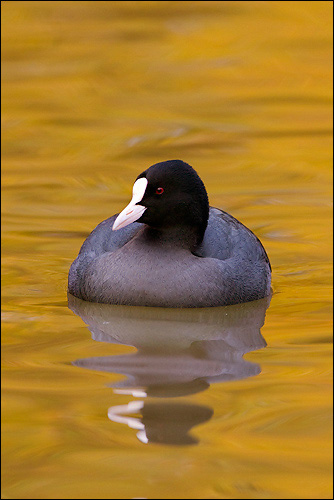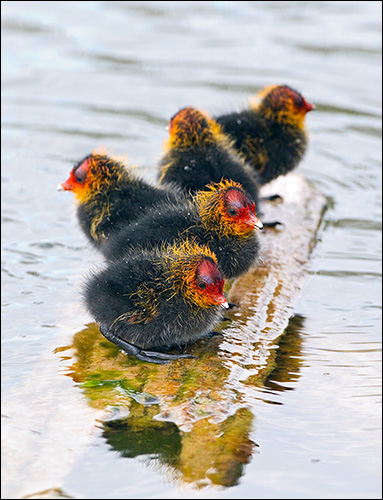Eurasian Coot (Fulica atra)
Most rails are shy and retiring, but the Coot is very easy to see. It is numerous, tame, often in flocks, very noisy and astonishingly irritable. Everywhere the Coot goes, the air is filled with its short-tempered “kut” calls (giving it its name), and various other clucks and discordant trumpets. Many quarrels are accompanied by splashes. An important threat display is an aggressive charge across the water – the “splattering attack”, and adult Coots also fight with their feet, the two birds leaning back in the water and striking each other with their long legs, as if they were kicking hard in the back-stroke.
An important icon of Coot society is the frontal shield. This prominent feature, set off by the coal black plumage, is larger in the male than the female, and larger in some individuals than others. It offers something of a challenge to other birds, especially when the head is lowered towards a rival.The aggression of the Coot sometimes goes beyond adult rivalry into something more sinister. Coots are normally attentive parents, dividing the labour evenly between them: for the first few days the female broods while the male brings food; and later the brood may be “split” between the two parents, with each adult feeding only its selected half. But occasionally and incongruously, a parent can be seen to attack a chick, grabbing its head and shaking it, sometimes fatally. The very opposite of parental care, this extreme behaviour may be related to food supply, the birds ensuring that there are not too many chicks taking meagre resources.
Watching Coots in the breeding season, one might facetiously suppose that the youngsters bring about murderous passions in their parents by their incessant cheeping pleas for food. The chicks look remarkably unlike the adults: they are fluffy, with minute stunted wings, heads stained with red or yellow, and with red bills. The period of parental care is quite long in the Coot, with the young only feeding themselves after about 30 days, much longer than in most rail species.This bird is mainly vegetarian, and it has diverse feeding methods. It will graze on land, swim with its head and neck immersed (often scraping algae from the rocks and vegetation), pick from shallow water and, of course, dive. It is rather limited in the latter, being somewhat buoyant. Its submersions are brief (20s maximum), it doesn’t go very deep, and it does not swallow its food underwater. As a result, it is a favourite victim of bullying ducks such as Gadwall, which requisition the Coot’s hard-won pickings as soon as they reach the surface. At times, though, Coots may use their aggression to turn the tables on their persecutors, or take it out on members of their own species that have found food nearby.


